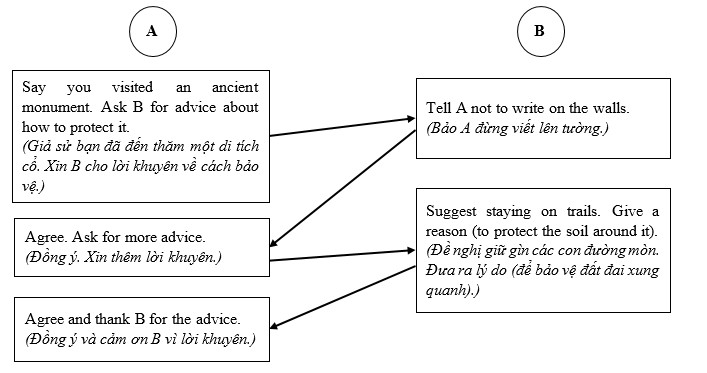Tiếng Anh 10 Bright Unit 6 6d. Speaking1. Fill in each gap with take, touch, make, volunteer, reduce, cross, stay or drop. Then listen and check. 2. Can you think of other ways to protect our national heritage? 3. Listen and read the dialogue. What does Sue want to protect? 4. Replace the underlined phrases/sentences in the dialogue in Exercise 3 with the ones from the Useful Language box. 5. You have visited an ancient monument. Act out a dialogue similar to the one in Exercise 3. Use the phrases/sentences from the Useful Language b
Lựa chọn câu để xem lời giải nhanh hơn
Bài 1 1. Fill in each gap with take, touch, make, volunteer, reduce, cross, stay or drop. Then listen and check. (Điền vào mỗi khoảng trống với các từ take, touch, make, volunteer, reduce, cross, stay hoặc drop. Sau đó lắng nghe và kiểm tra.) Heritage is something passed down from previous generations. It represents our history and our identity. It shows the link between our past, present and future. It is important to protect the heritage of the places we visit. Here are some simple ways. (Di sản là thứ được truyền lại từ các thế hệ trước. Nó đại diện cho lịch sử và bản sắc của chúng ta. Nó cho thấy mối liên hệ giữa quá khứ, hiện tại và tương lai của chúng ta. Điều quan trọng là phải bảo vệ di sản của những nơi chúng ta đến thăm. Dưới đây là một số cách đơn giản.) Preserve natural heritage (landscapes and wildlife) 1. __________________ on trails 2. don’t __________________ a lot of noise 3. _______________ to help with conservation projects 4. donate to a wildlife charity 5. __________________ your carbon footprint Preserve cultural heritage (architecture and monuments) 6. don’t __________________ litter 7. wear flat shoes with soft soles when you visit 8. don’t _____________ barriers 9. don’t ____________ surfaces 10. don’t ___________ souvenirs (pieces of stone, etc.) Lời giải chi tiết:
Preserve natural heritage (Bảo tồn di sản thiên nhiên) (landscapes and wildlife) (phong cảnh và động vật hoang dã) 1. stay on trails (giữ gìn đường mòn) 2. don’t make a lot of noise (đừng gây ồn ào) 3. volunteer to help with conservation projects (tình nguyện giúp đỡ các dự án về bảo tồn.) 4. donate to a wildlife charity (quyên góp cho một tổ chức từ thiện về động vật hoang dã) 5. reduce your carbon footprint (giảm lượng khí thải carbon) Preserve cultural heritage (Bảo tồn di sản văn hóa) (architecture and monuments) (kiến trúc và di tích) 6. don’t drop litter (không xả rác) 7. wear flat shoes with soft soles when you visit (đi giày bệt với đế mềm khi bạn ghé thăm) 8. don’t cross barriers (không vi phạm quy tắc) 9. don’t touch surfaces (không chạm vào bề mặt) 10. don’t take souvenirs (pieces of stone, etc.) (không lấy đồ lưu niệm (mảnh đá, v.v.)) Bài 2 2. Can you think of other ways to protect our national heritage? (Bạn có thể nghĩ ra cách khác để bảo vệ di sản quốc gia của chúng ta không?) Lời giải chi tiết: Some more ways to protect our national heritage are to protect natural wildlife, arrange clean-up days and avoid touching ancient ruins. (Một số cách để bảo vệ di sản quốc gia của chúng ta là bảo vệ động vật hoang dã tự nhiên, sắp xếp các ngày dọn dẹp và tránh chạm vào các di tích cổ.) Bài 3 3. Listen and read the dialogue. What does Sue want to protect? (Nghe và đọc đoạn hội thoại. Sue muốn bảo vệ cái gì?) Sue: I visited the castle yesterday. It’s so beautiful, but no one looks after it. What can we do to protect it? Ben: My advice is not to take souvenirs, like pieces of stone, from the castle. Sue: Good point. Is there anything else I can do? Ben: Well‚ have you thought about wearing flat shoes with soft soles when you visit? That way‚ you won’t damage the stones. Sue: That’s good thinking. Thanks! Phương pháp giải: Tạm dịch: Sue: Tớ đã đến thăm lâu đài hôm qua. Nó rất đẹp‚ nhưng không có ai chăm sóc cả. Chúng ta có thể làm gì để bảo vệ nó nhỉ? Ben: Tớ nghĩ không nên lấy đồ lưu niệm‚ như là những mảnh đá từ lâu đài. Sue: Nói hay đấy. Tớ có thể làm gì khác nữa không? Ben: À, cậu đã nghĩ đến việc đi giày bệt với đế mềm khi ghé thăm chưa? Bằng cách đó, bạn sẽ không làm hỏng những viên đá. Sue: Đó là ý kiến hay đấy. Cảm ơn cậu! Lời giải chi tiết: She wants to protect a castle. (Cô ấy muốn bảo vệ lâu đài.) Bài 4 4. Replace the underlined phrases/sentences in the dialogue in Exercise 3 with the ones from the Useful Language box. (Thay các cụm từ / câu được gạch chân trong đoạn đối thoại ở Bài tập 3 bằng các cụm từ / câu trong hộp Ngôn ngữ hữu ích.)
Lời giải chi tiết: What can we do –> What do you suggest My advice is –> I advise you (not) to Is there anything else I can do? –> Have you got any (other) suggestions? have you thought about –> have you considered Bài 5 5. You have visited an ancient monument. Act out a dialogue similar to the one in Exercise 3. Use the phrases/sentences from the Useful Language box and the diagram below. Mind the intonation and rhythm. (Bạn đã đến thăm một di tích cổ. Thực hiện một cuộc đối thoại tương tự như trong Bài tập 3. Sử dụng các cụm từ / câu từ hộp Ngôn ngữ Hữu ích và sơ đồ bên dưới. Chú ý đến ngữ điệu và nhịp điệu.)
Lời giải chi tiết: A: I visited an ancient temple yesterday. It’s so beautiful, but no one looks after it. What do you suggest to protect it? B: My advice is not to write on the walls of the ancient temple. A: Good point. Have you got any other suggestions? B: Well, have you thought about staying on the paths when you visit? That way, you won’t damage the soil around it. A: That’s good thinking. Thanks! Tạm dịch: A: Tớ đã đến thăm một ngôi đền cổ ngày hôm qua. Nó rất đẹp, nhưng không ai trông nom cả. Cậu có ý tưởng gì để bảo vệ nó không? B: Tớ nghĩ không viết lên các bức tường của ngôi đền cổ. A: Nói hay đấy. Cậu có gợi ý nào khác không? B: À, cậu đã nghĩ đến việc giữ gìn con đường khi ghé thăm chưa? Bằng cách đó, cậu sẽ không làm hỏng đất đai xung quanh. A: Đó là ý kiến hay đấy. Cảm ơn! Bài 6 6. Listen and repeat. Underline the consonants that make one sound. Which of these words do not contain a digraph? Practise saying them. (Lắng nghe và lặp lại. Gạch chân các phụ âm tạo thành một âm. Từ nào trong số những từ này không chứa digraph? Thực hành nói chúng.) • elephant • architecture • monument • northern • which • ship • penguin Phương pháp giải:
Lời giải chi tiết: - elephant (con voi) - architecture (kiến trúc) - northern (phía bắc) - which (cái mà) - ship (tàu) - monument (đài kỷ niệm), penguin (chim cánh cụt) do not contain a digraph (không chứa digraph)
>> 2K9 Học trực tuyến - Định hướng luyện thi TN THPT, ĐGNL, ĐGTD ngay từ lớp 11 (Click để xem ngay) cùng thầy cô giáo giỏi trên Tuyensinh247.com. Bứt phá điểm 9,10 chỉ sau 3 tháng, tiếp cận sớm các kì thi.
|
||||||||||||||||||||||






















